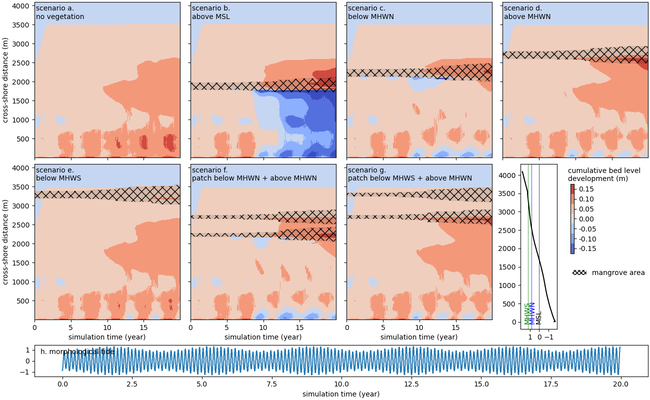S.M. Beselly1,2,3*, M. van Der Wegen1,4 , J. Reyns1,2,4, U. Grueters5,J.D. Dijkstra4,D. Roelvink1,2,4*
1 IHE Delft Institute for Water Education, the Netherlands; 2 Delft University of Technology, the Netherlands; 3 Universitas Brawijaya, Indonesia; 4 Deltares, the Netherlands; 5 Justus Liebig University Giessen, Germany
* Corresponding author: s.beselly@un-ihe.org
Introduction
There is global recognition to push forward mangrove restoration and conservation for climate mitigation and adaptation. This is owing to the multiple ecosystem services provided by mangrove ecosystems, e.g., sustainable coastal protection and high carbon sequestration capacity that potentially reach up to five times more than terrestrial forests. Unfortunately, although our understanding of mangrove processes has significantly improved, 80-90% of the reported restoration projects have experienced failures. Successful restorations require a set of systematic and structured stages consisting of planning, implementation, and evaluation. Once the suitable site is available, ensuring successful mangrove establishment is another challenge, regardless of different approaches used, e.g., ecological restoration, assisted rehabilitation/ planting, or community-based ecological mangrove. The main cause is a mismatch of mangrove species and a poor understanding of wetland hydro-morphological systems and ecological elements. Guidelines exist; however, they may be site-specific and cannot be easily replicated in other restoration cases. Hence, it emphasizes the need for a mechanistic understanding of mangrove ecosystem physical and ecological interactions.
Objective and Methods
In this research, we investigate the restoration strategies concerning mangrove configuration and response of mangrove attribute trajectories to optimize the carbon sequestration function. We apply a mechanistic and spatially explicit mangrove-eco-morphodynamic model, coupling the Delft3D-FM with the MesoFON model (Beselly et al., 2023). The model can describe mangrove-mudflat dynamics, including the life stage progression (mangrove establishment, growth, and mortality) along with the systems’ morphodynamic evolution conditioned by wave and tidal forcing, sediment availability, bed level change, and salinity. We used an idealized muddy open coast with a mudflat slope of 1:1000 forced by spring-neap tides and a single-wave climate. Eco-morphodynamic simulation resembling active reforestation is initiated with mixed species seedlings of Avicennia marina and Rhizopora apiculata planted at 3m distance intervals. We apply various configurations of mangrove placements, including single (200m) and multiple (100m with 160m gap) patches placed at a particular vertical level related to the tide (mean sea level, mean high water spring, and mean high water neap).
Results
Overall, our simulations show a large impact of planting zonation where it redistributes sediment across mudflat, with seaward erosion and in-forest-landward deposition. The presence of mangroves facilitates vertical accretion rate in the forest interior by up to twice compared to the no-vegetation scenario. There is a strong correlation between the relative position of the planting and Mean Sea Level (MSL) elevation. The scenario with mangroves near the MSL shows profound erosion at the seaward fringe. Meanwhile, scenarios above Mean High Water Neap have less erosion, and deposition is limited following the forest interior. Planting mangroves in patches and gaps has increased mangrove biomass development, expansion, and sediment accumulation compared to those planted in the lower elevation. We find total carbon stock capacity in patches and gap scenarios at higher elevations, which generally accumulate more than a single patch at lower levels. Within the same period, the single patch reaches its optimum capacity. Meanwhile, the multi-patches and gaps tend to keep expanding and accumulate sediment and biomass. Simulation results indicate the high dependency of sediment loss-gain on total carbon sequestration stocks. Therefore, it emphasizes the planting zonation suitability analysis to prevent counterintuitive carbon sequestration potential.

Simulated alongshore averaged bed level development. Panels show the spatiotemporal cumulative bed level development in each scenario. Mangrove extent is shown as black hatches on top of the bed level graph. Panel h shows the ocean boundary with morphological spring-neap tide forcing
References
Beselly, S.M., Grueters, U., Van Der Wegen, M., Reyns, J., Dijkstra, J., Roelvink, D., 2023. Modelling mangrove-mudflat dynamics with a coupled individual-based-hydro-morphodynamic model. Environ. Model. Softw. 169, 105814. https://doi.org/10.1016/j.envsoft.2023.105814


